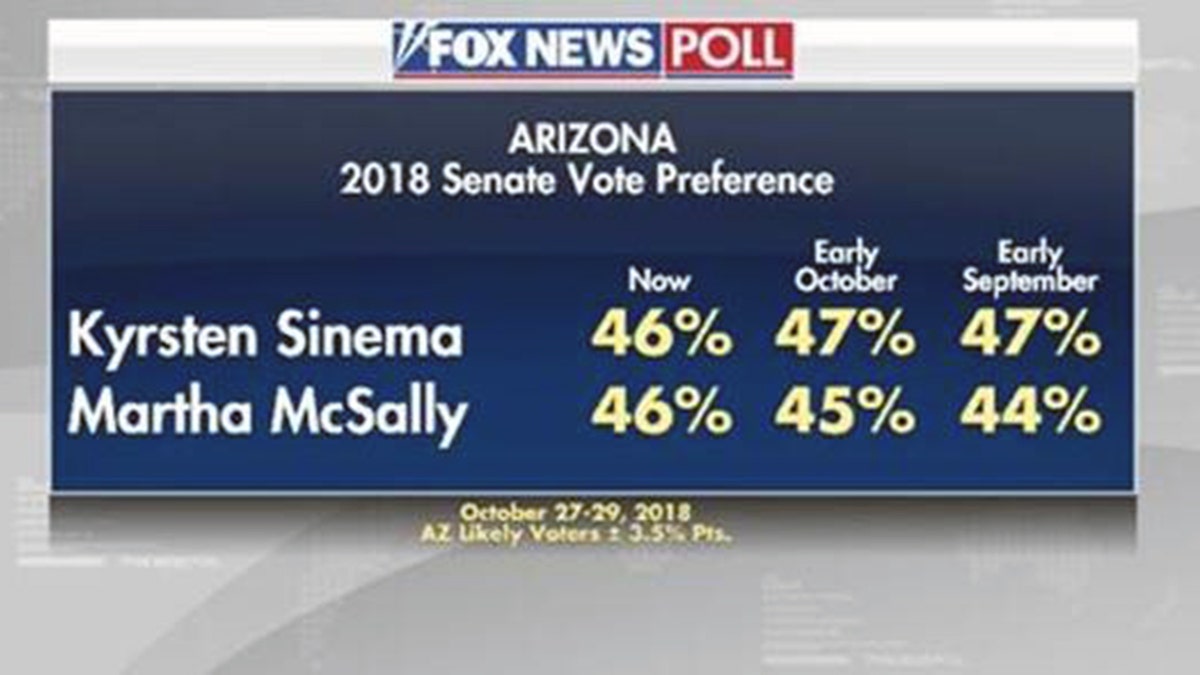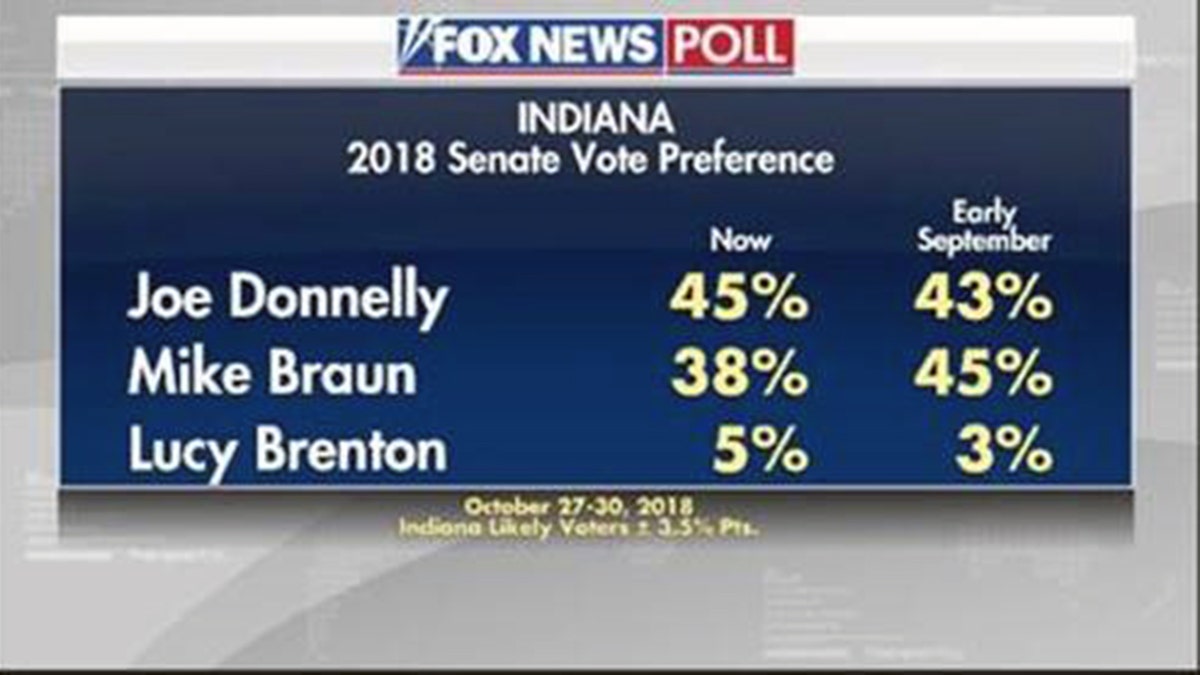Trump kicks off campaign blitz ahead of midterms
President Trump returns to the campaign trail with rallies in eight states before Election Day, including several states that he won in 2016 where Democrats are fighting to hold onto Senate seats.
A new round of Fox News battleground state polls proves we don’t call them battlegrounds for nothing. With six days until the election, three of the five U.S. Senate races could go either way -- and while Republicans hold leads in the other two, Democratic enthusiasm could still close the gap.
President Trump’s approval rating is at or above 50 percent in all. Yet in only two, North Dakota and Tennessee, does a GOP Senate candidate hit 50 percent support.
In two other states, Arizona and Missouri, the candidates are tied. The race in Indiana has reversed since early September -- however, one in five voters there who currently back a candidate say they may still change their mind.
No doubt, there will still be movement during the campaign’s final days.
Here are the state-by-state results, starting with Arizona:
Arizona
Democrat Kyrsten Sinema and Republican Martha McSally tie at 46 percent apiece among Arizona likely voters. Sinema was up by two points in early October and by three in September.
Hispanics prefer Sinema by 29 points, while rural whites favor McSally by 27.
CLICK FOR FULL ARIZONA POLL RESULTS
"Sinema's nearly two-to-one advantage among Hispanics means slightly higher Hispanic turnout than in the past could tip the race to the Democrat -- but the data doesn’t suggest a surge,” says Democratic pollster Chris Anderson, who conducts the Fox News surveys with Republican Daron Shaw.
The survey finds the number of Hispanic voters extremely interested in the election trails interest among non-Hispanic whites by 15 points.
Both Sinema (88 percent) and McSally supporters (88 percent) have a high degree of vote certainty, and equal numbers of Democrats (50 percent) and Republicans (50 percent) are extremely interested in the election.
Ninety-three percent of Democrats back Sinema, while 85 percent of Republicans support McSally. More Arizona voters identify as Republican than as Democrat by 10 points.

Five percent are still undecided about their vote in the Senate race.
The candidates are competing for the open seat of retiring Republican Sen. Jeff Flake.
Trump won Arizona by nearly four points. Currently, 52 percent of Arizona likely voters approve of the job he is doing, and 81 percent of Trump approvers are for McSally.
In the governor’s race, Republican incumbent Doug Ducey leads Democrat David Garcia by a comfortable 55-37 percent.
Indiana
Incumbent Democrat Sen. Joe Donnelly bests Republican challenger Mike Braun by seven points among Indiana likely voters, 45-38 percent. His lead is at the poll’s margin of error. The race shifted since September when Braun was up by two points. In early October, Donnelly was up by two.
Donnelly’s edge comes in large part from greater party loyalty and higher interest in the election among Democrats. Fully 88 percent of Democrats back him vs. 80 percent of Republicans for Braun. In addition, nearly 1 in 10 Republicans go for Donnelly. Independents are about twice as likely to support the incumbent.
CLICK FOR FULL INDIANA POLL RESULTS
More Democrats (49 percent) than Republicans (43 percent) are extremely interested in the race.
Eighty-three percent of Donnelly supporters and 80 percent of Braun supporters feel certain of their vote choice.

Nine percent of Indiana likely voters are undecided. Libertarian Lucy Breton takes five percent and that could be a wild card.
"Republican voters who flirt with Libertarian candidates tend to come home to the Republican candidate in the last few days,” says Shaw.
He adds, “Donnelly being under 50 percent bodes well for the less well-known challenger."
While Trump won Indiana by 19 points, more voters currently approve (50 percent) than disapprove (48 percent) of the job he is doing by just 2. In early September, more approved than disapproved by 10 (54-44 percent).
Missouri
The Missouri Senate race is a toss-up. Democratic incumbent Sen. Claire McCaskill and her Republican challenger Josh Hawley tie at 43 percent apiece.
Another four percent support another candidate, and nine percent are undecided.
CLICK FOR FULL MISSOURI POLL RESULTS
The race was also tied, 43-43 percent, at the beginning of October.
McCaskill has a 10-point advantage in party support: 93 percent of Democrats back her compared to 83 percent of Republicans going for Hawley. The preference among independents splits.

Men break for Hawley by four points. Women favor McCaskill by three.
Whites with a college degree support McCaskill by 6 points, while whites without a degree go for Hawley by 16.
More Democrats than Republicans are extremely interested in the election (55 vs. 48 percent respectively).
The candidates also tie in a hypothetical two-way matchup: 45-45 percent.
Among the subgroup of extremely interested voters, Hawley is up by three points in the two-way matchup, while McCaskill is up by one point in the expansive ballot.
Fifty-four percent of Missouri likely voters approve of Trump’s job performance, which nearly matches his 57 percent of the vote in 2016.
Tennessee
Republican Marsha Blackburn is pulling away from Democrat Phil Bredesen in the race to fill retiring Republican Sen. Bob Corker’s seat.
She is preferred 50-41 percent over the former governor among Tennessee likely voters. That 9-point lead is outside the poll’s margin of sampling error. She was up by five points in early October.
CLICK FOR FULL TENNESSEE POLL RESULTS
Blackburn’s advantage comes despite more Democrats (55 percent) than Republicans (48 percent) being extremely interested in the election -- as well as greater party loyalty among Democrats. Fully 92 percent of Democrats back Bredesen vs. 87 percent of Republicans supporting Blackburn.
It helps Blackburn that more Tennesseans identify as Republicans by a nearly 20-point margin.
There is a 35-point gender gap: women back Bredesen by 7 points and men support Blackburn by 28.

Eighty-eight percent of each candidate’s backers feel certain they will stick with their pick.
Trump remains popular in the Volunteer State. He won 61 percent of the vote here, and 58 percent approve of his job performance.
In the Tennessee governor’s race, Republican Bill Lee leads Democrat Karl Dean by 54-37 percent. Eleven percent of those backing Bredesen cross party lines to support Lee.
North Dakota
Democratic incumbent Sen. Heidi Heitkamp trails Republican Kevin Cramer by nine points. Cramer garners 51 percent to Heitkamp’s 42 percent among North Dakota likely voters.
In early October, Cramer had a 12-point lead (53-41 percent). Even though the race has narrowed a bit, it is the second time the Fox News poll shows him above 50 percent.
Cramer’s lead is outside the margin of error.
CLICK FOR FULL NORTH DAKOTA POLL RESULTS
In a state that went for Trump by 36 points, Heitkamp is able to keep the race as close as it is thanks to greater support among Democrats.
Ninety-four percent of Democrats back Heitkamp. Support for Cramer among Republicans stands at 85 percent. The vote preference among independents goes in Heitkamp’s favor by a narrow three points.
Many more North Dakotans identify as Republican than as Democrat.
There is a 22-point gender gap, as Heitkamp is the choice for women by 1 point and men go for Cramer by 21.
By a 5-point margin, more Democrats (56 percent) than Republicans (51 percent) feel extremely interested in the election.

Among Cramer supporters, 92 percent feel sure they will vote for him, while 88 percent of Heitkamp supporters say the same.
Four percent are undecided about their Senate vote, and eight percent who currently support a candidate feel they could change their mind.
Heitkamp outperforms the other Democrat on the ballot this year. Mac Schneider is running against Republican Kelly Armstrong to take the state’s lone House seat vacated by Cramer. Armstrong leads by 55-33 percent.
Sixty-one percent of North Dakota likely voters approve of the job Trump is doing. He won 63 percent of the vote in 2016.
The Fox News Poll is conducted under the joint direction of Anderson Robbins Research (D) and Shaw & Company Research (R). The poll was conducted October 27-30, 2018 by telephone (landline and cellphone) with live interviewers among likely voters in Indiana (722), Missouri (741), North Dakota (789) and Tennessee (718). Results based on the full sample of likely voters in each state except North Dakota have a margin of sampling error of plus or minus 3.5 percentage points. ND is plus or minus three points. Registered voters were randomly selected from a statewide voter file (except in ND where all eligible voters were included), and respondents answered screening questions about their likelihood to vote in the November elections. For Arizona, it is October 27-29 and 643 likely voters, plus or minus 3.5 points.




